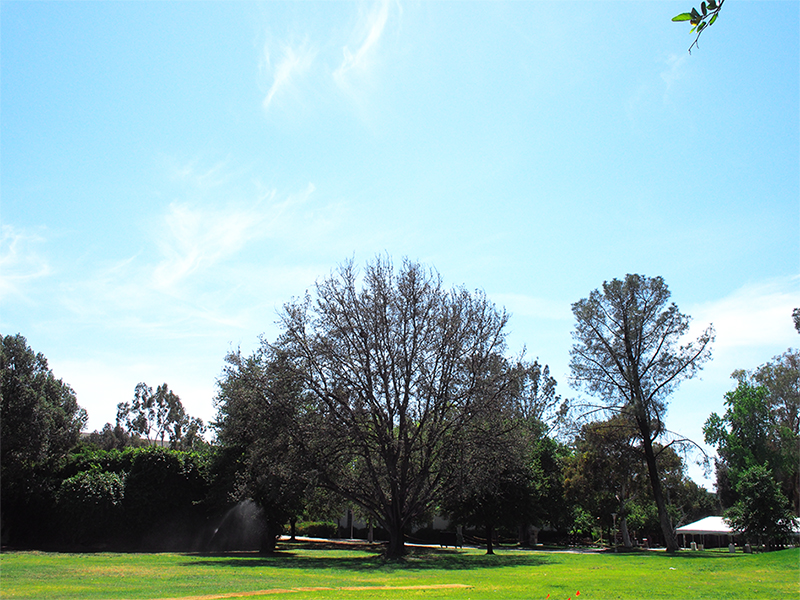
About 400 trees are being planted throughout UC Riverside with the help of a grant provided by the Green Trees for the Golden State Grant Program, a statewide initiative to support sustainable urban and community forests in California. The two-year-long project seeks to reduce the university’s carbon footprint in the midst of ongoing campus construction and expansion.
“We want to get as many trees as possible planted in the next year,” said Assistant Director of Landscape and Refuse Service at UCR‘s Physical Plant department Toshio Ishida. “It is impossible to have a 100 (percent) survival rate, but we want to stay as close as we can. We want to try to enhance the urban forest of the campus and provide a pleasant, safe environment.”
The grant will allow the university to receive up to $60,000 per tree planting and the total funds will be spent on new tree plantings, irrigation maintenance and associated labor costs
Ishida furthered that the grant money has ushered through additional campus improvements, as seen at UCR’s Picnic Hill, a grassy destination located east of the School of Medicine Research Building initially damaged due to outdated irrigation and insect infestation. The grant has already allowed the planting of its first 33 trees at Picnic Hill.
In addition, several dozen new trees were also planted along Linden Street, adjacent to the track field; and at the corner of Blaine Street and Watkins Drive, adjacent to the Child Development Center. The location of the tree plantings, according to Ishida, will be based on the loss of similar types of trees or where trees can aesthetically add to the existing campus landscape.
“We’ve documented a loss of several hundred trees over (many) years … and most of that was from (campus) expansion,” said UCR Director of Physical Plant Ken Mueller. “Construction’s going to happen because the campus is growing (and) there’s still a need for academic facilities.”
Partly as a result of the tree loss, the university is taking steps to incorporate the Leadership in Energy and Environmental Design (LEED) certification into the construction of all new buildings to make the university’s impact on the environment “as minimal as possible,” according to Mueller.
LEED, managed by the private nonprofit U.S. Green Building Council, is a nationally accepted rating system for the overall design, construction and maintenance of green buildings with the goals of enhancing environmental awareness. In 2012, the School of Medicine Research Building was recognized as the university’s first LEED-certified building.
Mueller adds that the grant will also assist the university in reaching a systemwide goal of carbon neutrality by 2025. Planting trees on campus is one way to offset the carbon footprint of a building, according to the physical plant director.
In addition, Ishida pointed out that, “Unlike a lot of other campuses, we have a fair amount of open land yet to be developed.” He explained that it would be beneficial to add trees to the developing areas so that the trees would mature by the time these areas are ready for campus integration.
Willow, pine, jacaranda, magnolia and live oak are among more than 20 different species of trees that are going to be planted, which Ishida notes are “approved as ones that will thrive in our area and grow to 30-plus feet in maturity.”
Especially with different types of tree species, Ishida says that new plantings are more delicate and require more attention than mature plantings. “Trees are living things,” Ishida said. “They die due to disease, pest infestation, windstorms and other factors. We want to help revitalize the area where that has happened.”
Mueller identifies coordination as one of the greatest challenges for initiating the project. “Over the next several months, we’ll be putting together projects, seeking student help and getting these trees planted,” he said. “It’s very labor intensive to plant a tree.” The Physical Plant department will be seeking collaboration with Transportation and Parking Services (TAPS), Capital Programs and volunteers from the UCR community.
Some students, such as Jesus Pompa, are supportive of this increase in “green” across campus. The first-year mathematics major explained that the trees “make the air quality a lot cleaner” and adding extra shade in Riverside’s desert climate will be beneficial.
However, Tedrick Mangasarian, a first-year neuroscience major, disagreed with the idea of adding more trees to campus, saying, “I really don’t like it. I mean, as you can see, we already have enough trees around the campus.” Mangasarian was also concerned that the tree planting might decrease space for additional campus activities in an already compact university.
The Green Trees for the Golden State Grant Program is part of the California Department of Forestry and Fire Protection (CAL FIRE), a California agency dedicated to protecting the 31 million acres of privately owned wildlands all around the state.








